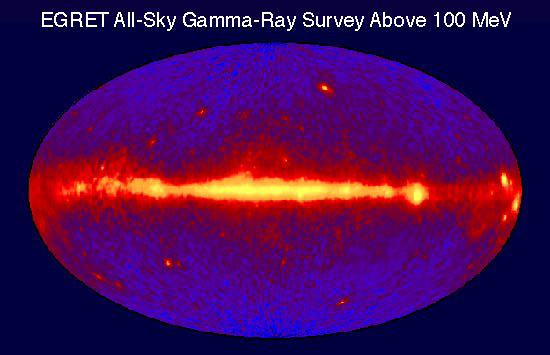Its time for another “Where in the Universe” challenge. I’ll admit, this one is a little unusual. And I’ll also admit, the picture here is just part of of a larger image. But, showing the entire image might give it away. Can you guess what this is? This challenge requires high energy for our readers to undertake, I know, and I appreciate everyone who has written to say how much they enjoy “Where in the Universe.” We search across the sky, across the galaxy, and across the universe to find unique images, and hopefully this challenge provides a welcome diversion to your day. Have you made a guess, formulated a speculation, or deduced a deduction? Or do you just know what this is? No peeking below until your guesses are in….
In honor of the successful launch of GLAST today, this image is in memory of the last orbiting gamma ray telescope, the Compton Gamma Ray Observatory. This is the all-sky map produced by the EGRET instrument, or the Energetic Gamma Ray Experiment Telescope. Here’s the full image:

This image shows the emissions from interactions between cosmic rays and the interstellar gas along the plane of our Galaxy, the Milky Way. Some point sources in this map are pulsars along the plane. For example, the Crab and Geminga pulsars are found near the extreme right side of the EGRET all-sky map. One of the major discoveries made by EGRET is the class of objects known as blazars – these are quasars that emit the majority of their electromagnetic energy in the 30 MeV to 30 GeV portion of the spectrum.
The Compton Gamma Ray Observatory was the second of NASA’s Great Observatories. Compton was launched on April 5, 1991 aboard the space shuttle Atlantis, and was safely deorbited and re-entered the Earth’s atmosphere on June 4, 2000.
How’d you do?
Image source: Compton Gamma Ray Observatory site


I was thinking when ‘Captain’ Sulu says “Shields!!!”
I was about to guess that it was the Milky Way in X-rays, but then I recognized it! The slight curvature visible even in the cropped image gives it away: it’s the cosmic microwave background with the Doppler shift removed, but the radio noise from the Milky Way left in.
Ooooh, epic fail! x_X My first guess was closer… 😛
This is the Milky Way. Not sure what’s the frequency, though, but if you say we need “high energy” for it, then I’d guess it’s either X or Gamma rays. 😉
No clue as to the spacecraft that shot the picture…
Now to read the rest of the article… and… Compton Gamma Ray Observatory. OK. Overall not bad, I guess. 🙂
I guessed either the view of the sun at a near eclipse or the energy barrier at the edge of the galaxy that the Enterprise’s deflectors say is there but the sensors say its not (and can fry the ships electronics if it flies though)!
Were there intentional clues in this article (referring to high energy and “search across the sky”)?
Another tough one. Keep it up! Thanks!
When I opened UniverseToday today, and saw the pics without noticing it is an Universe Challenge, I told “wow, GLAST image already!?”, but then realized it is extremely unlikely to have any images from the GLAST yet. Then seeing the challenge, it was clear it is the gamma imagery from the older probe.
i knew it was the milky way, just not quite what i was seeing.
Woo hoo! I nailed yet another Challenge! I immediately figured it to be the disk of the Milky Way and your hint about “high energy” caused me to choose the gamma-ray image. Jeenyus I tell ya! I love these challenges! I’d suggest a “close up image” of an Io volcano sometime in the future. Hehehe.
This is the plasma ribbon that stretches from Sirius to Andromeda in place to annihilate the evil hordes of locust like beings before they return to wreak havoc on the soft bodied species of earth.
I knew it was the milky way but don’t know anything about gamma ray shots
hi- im an 11 year old kid obsessed with the universe- i have this massive book about the universe and i immediately knew that this was the milky way- nice idea on where in the universe?